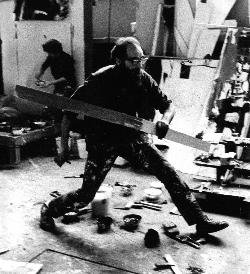Emilio Vedova 1919-2006
dal 23/1/2008 al 19/4/2008
Segnalato da
23/1/2008
Emilio Vedova 1919-2006
Berlinische Galerie, Berlin
An extensive retrospective on the Venetian painter, who is among the most significant artists of gestural abstract painting in Europe. The show includes about 150 works from all his creative periods. It starts with early figure and architecture drawings of the 1930s as well as with pastels and geometrics from the 1940s, to end up with an installation made of 19 Tondi and Dischi - works on wooden discs with a diameter of 2.80 meters that are standing or laying on the floor or are hung up in the exhibition space. Moreover, on display a new presentation of the collection spans the period from World War 1 to the 70s.

At the start of this year, the Berlinische Galerie presents for the first time in Germany an extensive retrospective on the Venetian painter Emilio Vedova, who is among the most significant artists of gestural abstract painting in Europe. Vedova felt closely connected to the city of Berlin ever since his stay there from the end of 1963 to mid 1965 as ‘artist in residence’ funded by the Ford Foundation.
The Berlinische Galerie has been able to realize this major retrospective, Emilio Vedova 1919-2006, in collaboration with the Galleria Nazionale d’Arte Moderna in Rome and the Emilio and Annabianca Vedova Foundation in Venice. Vedova was also very much involved in the development of this large exhibition of his work until his death on October 25, 2006. The exhibition, open from January 25 until April 20, 2008, shows a cross-section of all of the artist’s creative periods – from his first to his last work. The retrospective is complemented by documentary film material and an ambitious supporting program developed in cooperation with the Italian Cultural Institute Berlin. In addition, the Berlinische Galerie is showing six large works by Georg Baselitz – these works were shown at the Biennale di Venezia 2007 as part of tribute to Vedova in the Venetian Pavilion.
Emilio Vedova is the leading representative of Italian abstract expressionism and is regarded as one of the most important post-war artists in Italy. His work has been honored with numerous prizes such as the Golden Lion of the Venice Biennial for his life’s work (1997) and most recently in 2004 with the Art Prize of NORD/LB Hanover. Vedova has exhibited works four times at documenta and was a regular at the Venice Biennial. In 1993, the artist was selected to become a member of the Academy of Arts in Berlin. A good year after Vedova’s death, the Berlinische Galerie would like to do justice to the Venetian painter’s impressive and substantial creations with his first extensive retrospective in Germany.
On the exhibition
The retrospective includes about 150 works from all creative periods of the Venetian painter. It starts with early figure and architecture drawings of the 1930s as well as with pastels and geometrics from the 1940s. The works from the 1950s such as Zusammenprall gegensätzlicher Situationen ’59 (Clash of conflictive situations ‘59) illustrate Vedova’s focus on large-size, abstract-expressive painting. Already at the beginning of the 1960s, Vedova frees himself from the classic painting space by opening up his painting to the space. Inspired by a collaboration with Luigi Nono the first Plurimi are created in 1962 – painting and collage on free-standing or hanging, multilateral wooden frames that can be moved. During his artist-in-residence stay in Berlin, Vedova creates his Absurdes Berliner Tagebuch ’64 containing seven Plurimi that are the centerpiece of the museum’s collection since they were donated by the artist to the Berlinische Galerie in 2002. In the following decades, Vedova radically develops the abstract-expressive painting in space. Next to large-size canvases from the 1980s, the works of the cycle … in continuum, Durchdringungen – Übertragungen ‘87/’88 (… in continuum, pervasions – transfers ‘87/’88) or the so far lesser known Karnevale, the exhibition impresses its visitors with an installation made of 19 Tondi and Dischi – works on wooden discs with a diameter of 2.80 meters that are standing or laying on the floor or are hung up in the exhibition space.
The catalog and the exhibition Emilio Vedova 1919-2006 in the Berlinische Galerie are made possible by the Stiftung Deutsche Klassenlotterie Berlin (German Lottery Trust).
................................
FINE ARTS, PHOTOGRAPHY, ARCHITECTURE 1914 -1968
The new presentation of the collection spans the period from World War 1 to the 70s.
200 works -- painting, graphic art, photography, sculpture, and photography – show the artistic approach to the different departures, upheavals, and collapses of that time.
Special emphasis is given to the years around 1968. The GFR, the land of the “wirtschaftswunder,” was radically called into question by what is called the 68 generation. The movement compelled their fathers to look back to their past, new concepts of life were developed, politically-motivated communes were founded, and free love was the order of the day. Young artists, such as Georg Baselitz and Eugen Schönebeck, countered abstraction with figuration, Wolf Vostell and Edward Kienholz did décollages, happenings, and environments to point out the sociopolitical situation. This kind of artistic rebellion had been prepared by the Novermbergruppe: In the 20s East-European and German avant-garde artists had already worked on a new concept for art as well as for life.
Press info
Jutta Berg Tel +49 (0) 30 - 78902 833 Fax +49 (0) 30 - 78902 730
berg@berlinischegalerie.de
Opening January 24, 2008, 7 PM
Berlinische Galerie
Alte Jakobstrasse 124-128 - Berlin



